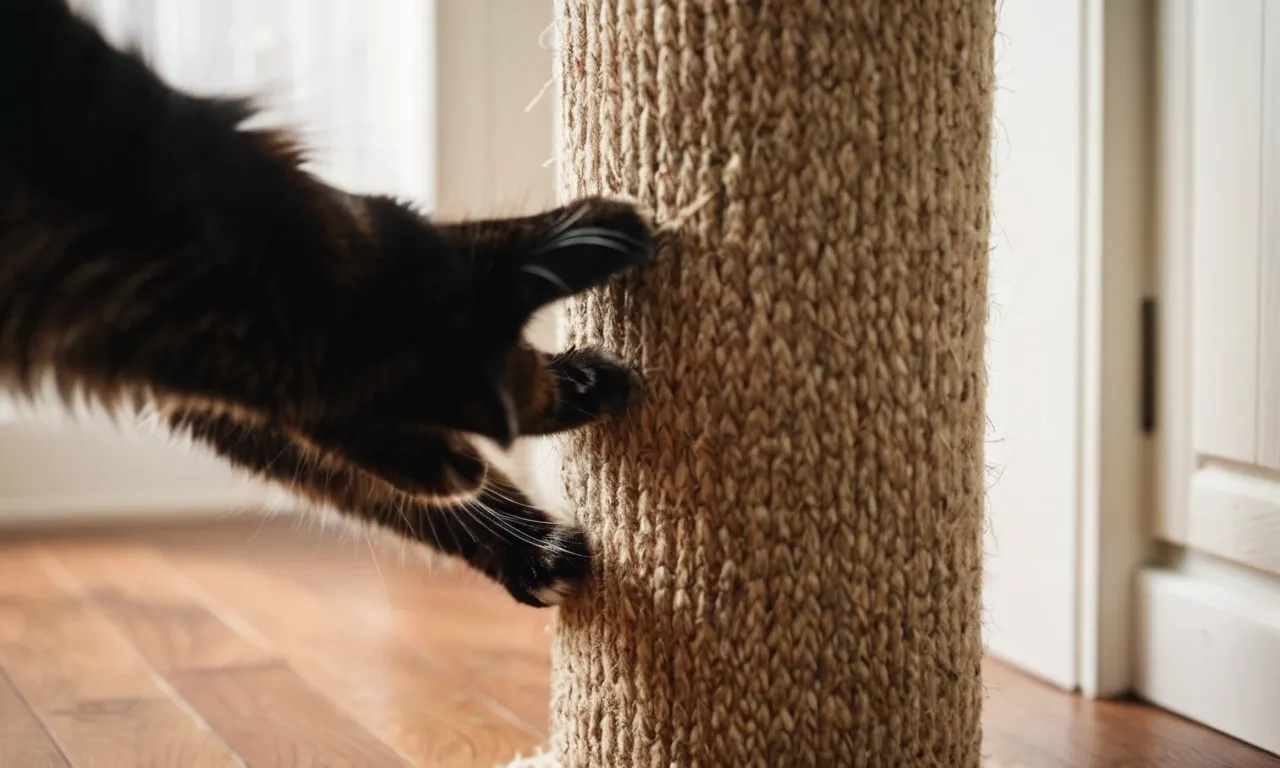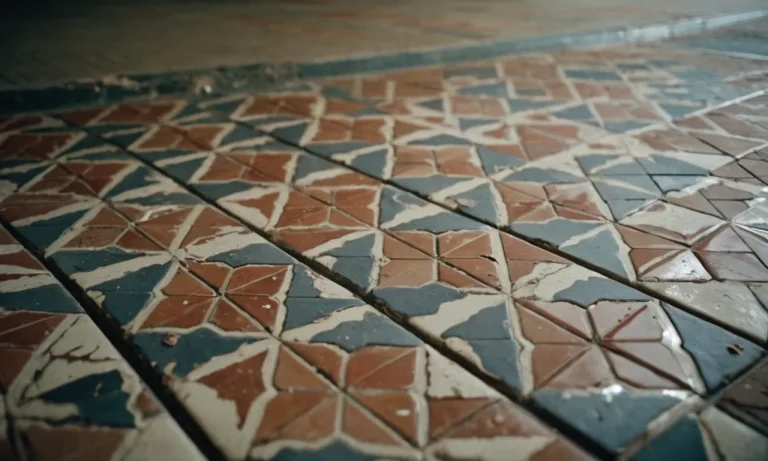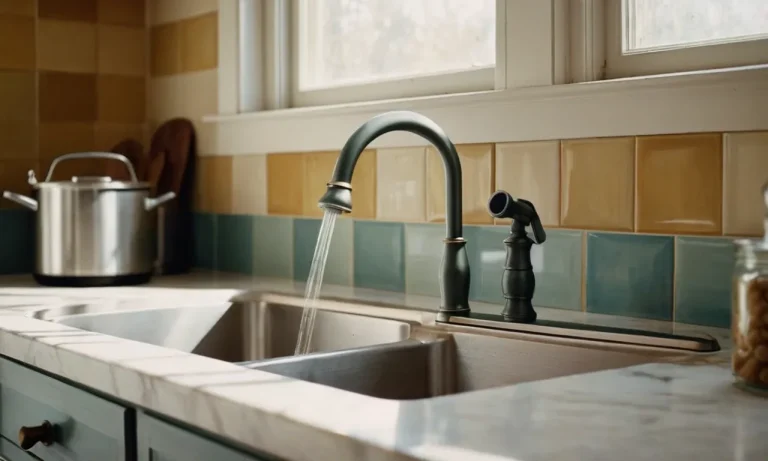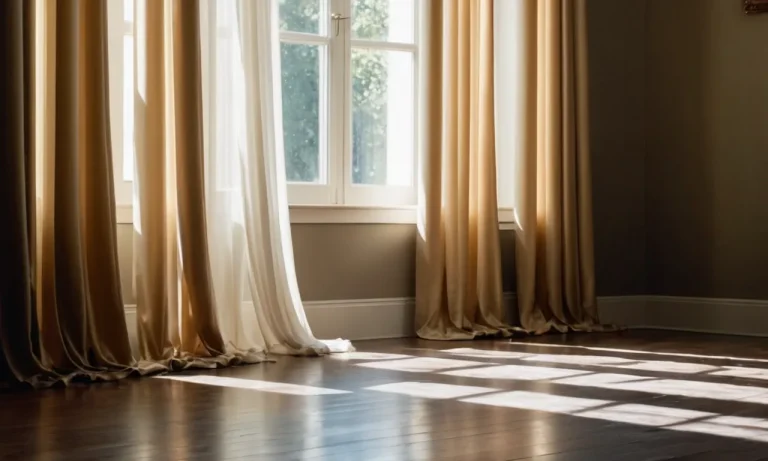How To Stop A Cat From Scratching Doors And Walls
Cats scratching doors, walls, and furniture is a common problem for pet owners. If your cat is scratching surfaces around your home, it can damage your property and cause frustration. Fortunately, there are effective ways to stop this behavior.
If you’re short on time, here’s a quick answer to your question: Provide appropriate scratching surfaces like posts and boards around the house, use cat repellent sprays on problem areas, trim your cat’s nails regularly, and consider products like Soft Paws nail caps.
In this comprehensive guide, we will cover why cats scratch, how to stop scratching behaviors, the best scratching solutions to protect your home, and tips for training cats to use proper scratching posts.
Understanding Why Cats Scratch Objects
Scratching is a natural behavior for cats, and it serves several important purposes. By understanding why cats scratch, we can better address their needs and find ways to redirect their behavior.
Instinctual Need to Scratch
Cats have an instinctual need to scratch, which is deeply rooted in their biology. Scratching helps them shed the outer layer of their claws, keeping them sharp and healthy. It also provides them with a form of exercise, stretching their muscles and keeping them strong.
Additionally, scratching allows cats to maintain their flexibility and agility.
It is important to note that scratching is not a destructive behavior, but rather a necessary one for cats. Providing them with appropriate outlets for scratching, such as scratching posts or boards, can help satisfy this instinctual need without causing damage to your doors and walls.
Marking Territory
Scratching also serves as a way for cats to mark their territory. When a cat scratches an object, it leaves behind visual and scent markers from the glands in their paws. These markers communicate to other cats that the territory is claimed and can help reduce conflicts between cats in multi-cat households.
Understanding this territorial aspect of scratching can help us address the issue. By providing cats with designated scratching areas, we can help them feel secure in their territory and reduce the likelihood of them scratching doors and walls.
Stress Relief
Scratching can also be a form of stress relief for cats. Just like humans might engage in activities like squeezing stress balls or tapping their fingers, cats scratch as a way to release tension and anxiety.
This behavior helps them cope with environmental changes, such as moving to a new home or the introduction of a new pet.
It is important to provide cats with a stress-free environment and plenty of opportunities for mental and physical stimulation. This can include interactive play sessions, puzzle toys, and vertical spaces for climbing.
By addressing the underlying stressors, we can help reduce the likelihood of cats resorting to scratching doors and walls as a coping mechanism.
For more information on cat behavior and how to address scratching issues, you can visit https://www.aspca.org/pet-care/cat-care/common-cat-behavior-issues/scratching.
Providing Appropriate Scratching Surfaces
Scratching Posts
One of the most effective ways to prevent your cat from scratching doors and walls is to provide them with appropriate scratching surfaces. Scratching posts are a popular choice among cat owners. These posts are typically made of sisal rope or carpeting, which provides a satisfying texture for cats to scratch on.
Placing a scratching post near the area where your cat tends to scratch can redirect their behavior. Make sure the post is tall enough for your cat to fully stretch out while scratching. Encourage your cat to use the scratching post by praising and rewarding them when they use it instead of the door or wall.
Expert Tip: To make the scratching post more enticing, you can rub it with catnip or attach a toy to it. This will make the post even more appealing to your furry friend!
Scratching Boards & Mats
In addition to scratching posts, you can also provide your cat with scratching boards or mats. These are often made of cardboard or sisal and can be placed on the floor or mounted on walls. Scratching boards and mats provide a different texture for your cat to scratch on, offering variety in their scratching options.
Some cats may prefer horizontal scratching surfaces, so having a scratching board or mat can be beneficial in preventing them from scratching your doors and walls.
Did you know? Cats scratch to mark their territory, stretch their muscles, and remove the dead outer layer of their claws. By providing appropriate scratching surfaces, you are allowing your cat to engage in these natural behaviors while protecting your home.
Scratching Houses & Trees
If you have the space and budget, you can consider investing in a scratching house or tree for your cat. These larger structures provide multiple scratching surfaces, as well as platforms for climbing and perching.
Scratching houses and trees can be particularly beneficial if you have multiple cats or a cat who loves to climb. They offer a variety of textures and heights, giving your cat plenty of options to satisfy their scratching needs.
Expert Tip: When choosing a scratching house or tree, look for sturdy construction and materials that can withstand your cat’s scratching. You want to ensure that the structure is stable and safe for your furry friend to enjoy.
Proper Location & Number of Surfaces
In order to effectively redirect your cat’s scratching behavior, it’s important to place the appropriate scratching surfaces in strategic locations. Pay attention to where your cat tends to scratch the most, whether it’s near a specific door or wall.
Position the scratching posts, boards, mats, or houses near these problem areas to provide an alternative for your cat.
Additionally, having multiple scratching surfaces throughout your home can be beneficial. This allows your cat to have options and reduces the likelihood of them resorting to scratching your doors and walls. Ideally, there should be at least one scratching surface per cat in your household.
Fun Fact: Did you know that cats have scent glands on their paws? When they scratch, they are not only marking their territory visually but also leaving behind their scent.
Remember, it may take some time and patience to train your cat to use the appropriate scratching surfaces consistently. Be consistent with positive reinforcement and redirecting their behavior when necessary.
With the right scratching options and a little training, you can help your cat break the habit of scratching doors and walls.
Using Aversives to Deter Scratching
Scratching is a natural behavior for cats, but it can be frustrating when they target our doors and walls. Fortunately, there are several aversive methods you can try to discourage your cat from scratching these surfaces.
Aversives are substances or devices that create an unpleasant experience for your cat, deterring them from engaging in unwanted behaviors. Here are some effective aversive options to consider:
Cat Repellent Sprays
Cat repellent sprays are a popular choice for discouraging cats from scratching doors and walls. These sprays contain scents that are unpleasant to cats, such as citrus or lavender. By spraying the repellent on the targeted surfaces, you can create an aversive environment for your cat.
It’s important to choose a cat-safe repellent that won’t harm your furry friend or leave behind any stains or residue.
Sticky Paws Tape
Sticky Paws tape is a double-sided adhesive tape that can be applied directly to doors and walls. Cats dislike the sticky texture and will be deterred from scratching these surfaces. The tape is transparent and won’t damage your furniture or leave any residue behind.
It’s an effective and non-toxic option for preventing your cat from scratching doors and walls.
Ssscat Automated Deterrent
The Ssscat automated deterrent is a motion-activated device that emits a harmless burst of air when your cat approaches the protected area. This sudden blast startles them and discourages them from scratching.
The device is easy to set up and can be placed near doors or walls to prevent your cat from engaging in this behavior. It’s a humane and effective solution for deterring scratching.
Foil & Plastic Coverings
Another simple and cost-effective method to deter scratching is to cover the targeted surfaces with foil or plastic. Cats dislike the texture and sound of these materials, and they will be less likely to scratch when faced with them.
You can easily attach foil or plastic sheets to doors and walls using tape or adhesive. This method is temporary and can be used as a training tool to redirect your cat’s scratching behavior.
Remember, it’s important to provide your cat with appropriate scratching alternatives, such as scratching posts or boards. This will help redirect their natural scratching instinct to a more suitable surface.
Additionally, positive reinforcement and rewards for using the desired scratching areas can further encourage your cat to avoid scratching doors and walls.
Reducing Damage with Nail Trims and Caps
Trimming Tips
One effective way to prevent your cat from scratching doors and walls is by regularly trimming their nails. This will help to reduce the damage caused by scratching. Here are some tips to make the nail trimming process easier for both you and your feline friend:
- Start by getting your cat comfortable with having their paws touched. Gently massage their paws and reward them with treats or praise.
- Use cat-specific nail clippers or a small pair of human nail clippers with a straight edge. Avoid using scissors, as they can easily injure your cat.
- Hold your cat’s paw and gently press their pad to extend the claws. Trim only the white part of the nail, avoiding the pink area known as the quick, as it is sensitive and can cause bleeding.
- If your cat becomes anxious or aggressive during the process, take a break and try again later or seek assistance from a professional groomer or veterinarian.
Soft Paws Nail Caps
If trimming your cat’s nails is proving to be a challenge, another option to consider is using soft nail caps, such as Soft Paws. These caps are applied to your cat’s claws to prevent them from causing damage when scratching.
Soft Paws nail caps are made of a soft, non-toxic material that is safe for cats. They are available in various sizes and colors to suit your cat’s needs. The caps are applied using a special adhesive and can last for several weeks before they need to be replaced.
It is important to note that while Soft Paws can help prevent damage to doors and walls, they do not completely eliminate the need for regular nail trims. Cats’ nails will continue to grow, and the caps will eventually fall off as the nails shed naturally.
Regular maintenance and monitoring of your cat’s nails are still necessary.
If you’re unsure about trimming your cat’s nails or applying nail caps, consult with your veterinarian or a professional groomer. They can provide guidance and demonstrate the proper technique to ensure the safety and comfort of your cat.
Training Cats to Use Proper Surfaces
When it comes to preventing cats from scratching doors and walls, one effective approach is to train them to use proper scratching surfaces. By providing them with suitable alternatives, you can redirect their natural urge to scratch towards more appropriate objects.
Positive Reinforcement
Positive reinforcement is a highly effective method for training cats. Whenever you catch your cat using the designated scratching post or pad, be sure to reward them with praise, treats, or playtime. This positive association will encourage them to continue using the approved surfaces.
It’s important to remember that punishment or scolding should never be used as a training method. This can create fear and anxiety in your cat, and may even exacerbate their scratching behavior.
Scratching Surface Preferences
Every cat has their own preference when it comes to scratching surfaces. Some cats prefer vertical surfaces, such as scratching posts or tree trunks, while others may prefer horizontal surfaces, like cardboard scratching pads.
Observe your cat’s scratching habits to determine their preferences. Experiment with different types of scratching surfaces to find the one that they are most attracted to. Providing a variety of options throughout your home can also help prevent them from targeting your doors and walls.
Redirecting Scratching
If you catch your cat scratching doors or walls, gently redirect their attention to a designated scratching surface. Use a toy or a treat to entice them towards the appropriate object. Over time, they will learn to associate scratching with the approved surfaces instead of your doors and walls.
Additionally, you can make the doors and walls less appealing for scratching by using deterrents such as double-sided tape or aluminum foil. Cats dislike the sticky texture of tape and the sound and feel of foil, which can discourage them from scratching these surfaces.
Consider Clicker Training
Clicker training is a method that uses a small handheld device that makes a clicking sound. This sound is paired with a reward, such as a treat, to reinforce positive behaviors. By using a clicker, you can effectively communicate to your cat that scratching the appropriate surfaces is desirable.
Clicker training can be a useful tool in teaching your cat to use scratching posts and pads. With patience and consistency, you can train them to understand that the clicker sound means they will receive a reward for using the designated surfaces.
Remember, training a cat requires time and patience. It’s important to be consistent and reward their desired behaviors. By implementing these training techniques and providing suitable scratching alternatives, you can help prevent your cat from scratching doors and walls.
Conclusion
Stopping cats from scratching inappropriate objects in your home takes some patience and consistent training. By providing enticing scratching posts, deterring certain areas, and keeping nails trimmed, you can curb this natural behavior.
Make sure to positively reinforce your cat when they use surfaces you do want them to scratch. With time, you’ll be able to protect your home furnishings while still allowing cats their instinctual scratching.







